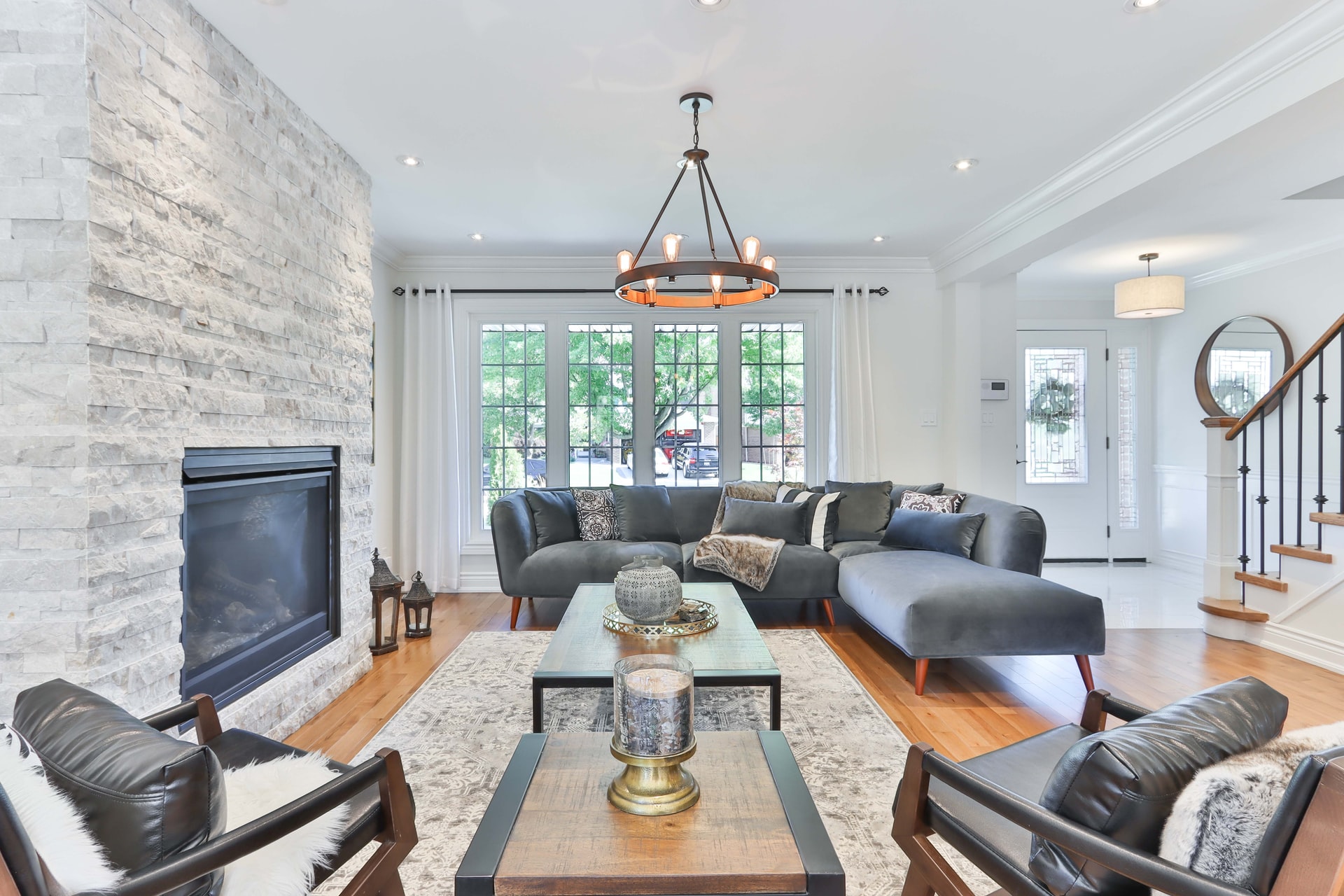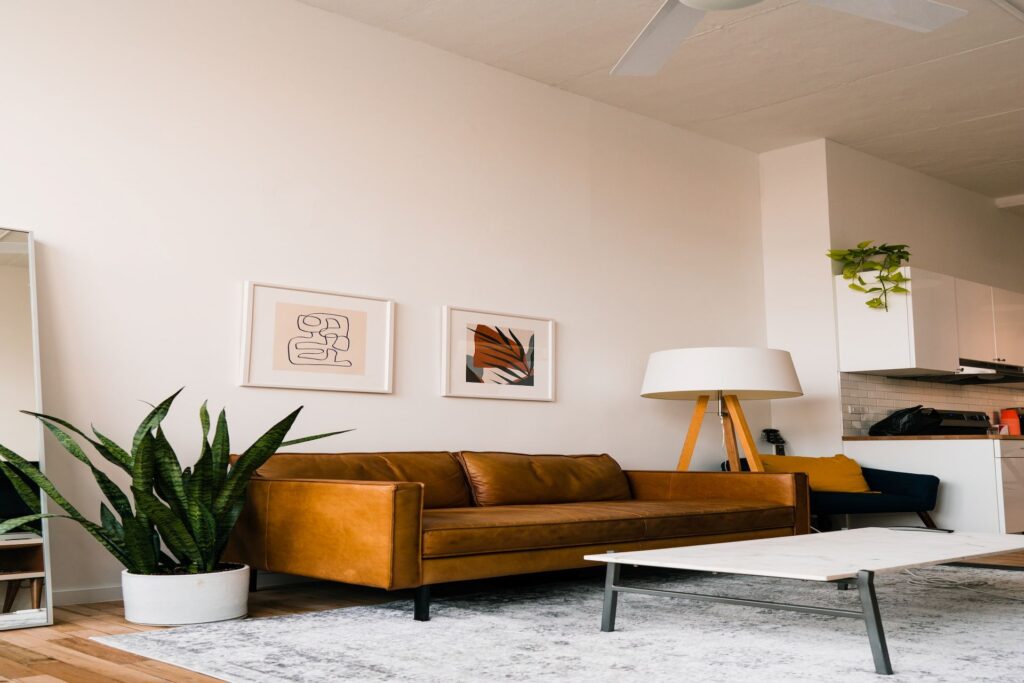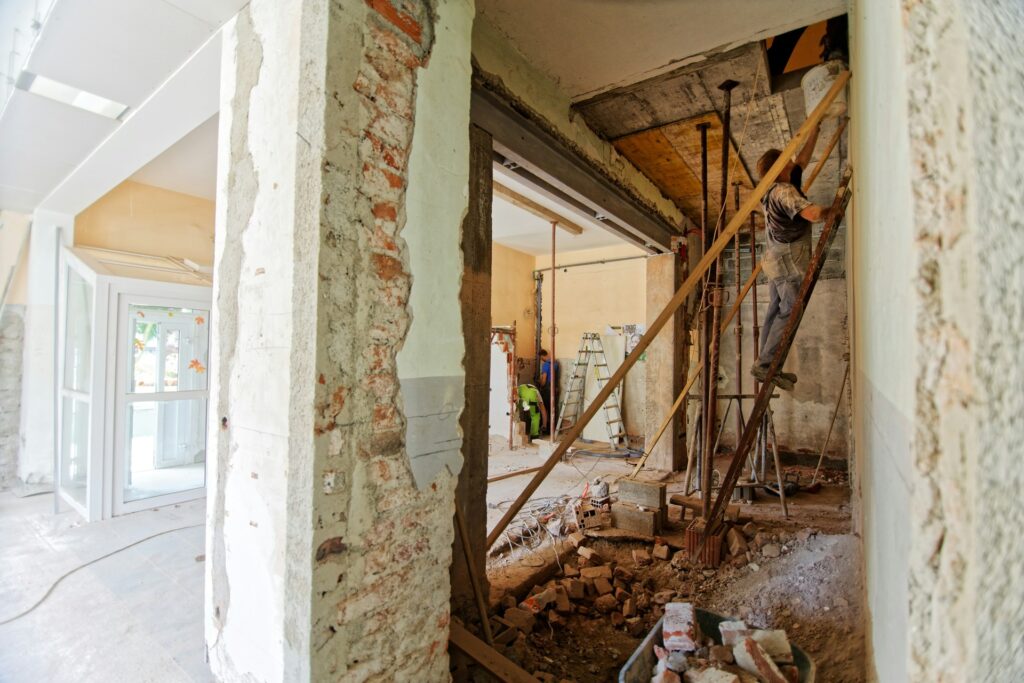
We are reader-supported. When you buy through links on our site, we may earn an affiliate commission.

A living room remodel can be an equally exciting and stressful experience. With so many options to choose from, from layout to design, you may wonder what the best approach is to tackle your next home project.
Before you begin thinking about paint colors, floors and decor, you need to consider what you actually want to do with the space. Is this a major renovation or a smaller DIY project? Will you need to hire a contractor? How much have you budgeted for this remodel?
If you find yourself panicking about your living room remodel before you even have the chance to begin, you can finally breathe and relax. This guide will help you every step of the way.
Do Your Research
Before you start your living room remodel, you want to do your homework. Take time to plan what you want, so you have fewer changes down the line. Watch HGTV, follow interior design accounts, or get inspiration from your friends’ homes. Narrowing down your style makes it easier to make fast decisions.
Another essential part of planning is having a budget in mind. That way, you don’t splurge on things you might not need, like a new countertop.
As you do you’re planning, consider your lifestyle. How do you want to use the space? For example, are you into entertaining? Then you may wish to several different seating areas. On the other hand, suppose you want a space to relax with family. Then you may want to have one larger seating area for more intimacy.
Also, if you have animals look for pet-friendly furniture, like leather. Another thing to consider is your long-term plans. For example, are you hoping to have kids in the future? Then you want to have a more open layout, so children can run around safely.
Make a Remodel Plan
The first step in remodeling your living room is to make a plan and jot it down. You’ll want to include every detail possible, including measurements and the type of furniture you will want to bring into the space.
If you choose to hire a contractor, they can assist you with a blueprint for your new living room. Of course, it’s helpful to have some ideas in mind beforehand.
Decide how you want the layout to look and anything you’d like to include — maybe an extra window, skylights or a new fireplace. For an even more accurate depiction of your remodeling plans, software programs are available to create renderings of your future living room design without needing to draw them out by hand.
1. Have a Theme
You want to determine a design theme for your living room to feel more cohesive. This will also make it easier to pick out decor. So, you could have a farmhouse aesthetic and include multiple wooden pieces. If you want a more romantic setting, use reds or pink hues with soft lighting. Look at design books or magazines to get more inspiration.
Here are a few more themes to consider:
- Contemporary
- Coastal
- Eclectic
- Cottage style
- Bohemian
2. Design a Room Board
Before heading to the store, create a room board. This is an important step in a living room remodel to ensure all the furniture fits within the space. It gives you a visual representation of how everything will work together.
For example, maybe you notice a rug pattern clashing with a piece of curtain fabric. Catching these things earlier will save you money and stress. Consider playing around with different layouts before choosing your favorite one.
3. Measure the Room
Before you start adding new decor, know the living room’s square footage. This will allow you to pick the right size furniture and prevent a trip back to the store. In turn, you then end up saving both time and money.
Here are the steps to measuring your space:
- Measure the door where you’ll bring in the furniture. Get the height and width and the diagonal measurement from top left to bottom right. Remember to get the numbers inside the door frames.
- Measure from the entrance to the far wall.
- Record the length and width of the room.
- Measure the height of the walls.
- Measure any architectural features, such as doorways, windows or fireplaces.
Budget Your Project & Set Plan in Motion
Homeowners may spend $4,000 to $10,000 on a major living room renovation to upgrade floors, paint, crown molding and the fireplace. With these costs in mind, you’ll want to think long and hard about how you will finance and budget your home improvement project.
Perhaps you’ve been saving up for a long time and can cover the renovating costs yourself. Even if you can partially cover the costs, some money set aside is better than none. Additional home renovation financing options may include the following:
- Home improvement loans or home repair loans
- Home equity line of credit (HELOC)
- Home equity loan
- Cash-out refinancing
- Credit cards
- Government loans, such as a HUD Title I Property Improvement Loan
There’s a lot to consider when coming up with the funds for your living room remodel. You should speak to an advisor regarding your options and choose the best plan for your individual financial situation.
Meanwhile, begin thinking of different ways you may be able to save money. Create a spreadsheet of the must-have items in your renovation, including the furniture you may want to replace or reupholster. According to Bruce Graf of Graf Developments, you should set aside a contingency fund of about 10% for unforeseen circumstances during construction or design extras.
1. Head to the Store
Once you have a style in mind, it’s time for the fun part, which is shopping. Start by taking inventory of what you have at home. For example, do you have a chair from your bedroom you can bring downstairs? Repurposing items saves you money and is good for the environment. It can also be a fun way to add a personal touch. For example, you could display your grandmother’s sewing machine.
The one thing to consider is how well these pieces will blend into your new space. When you shop, start at affordable retailers, like Walmart, to stay on budget. Another tip is to spread out your purchases and buy larger pieces first, such as the sofa.
2. Hire a Contractor
Some living room remodels are easy to tackle on your own. Meanwhile, it’s best to leave large renovations to the professionals.
Once you know how you’d like to revamp your living room, you should look for a reputable general contractor. This step demands a bit of research and patience on your part. You’ll want to begin your search by reading online reviews and speaking with friends, family and neighbors who’ve used contractors for their own home improvement projects.
Call general contractors with extensive remodeling and renovation experience and ask them the following questions:
- How many years have you been in the remodeling business?
- Do you have a portfolio of previous living room renovations you’ve done?
- Do you hold the correct permits and licenses according to the state?
- Do you have a list of references?
- What is the typical timeframe for this sort of project?
- What is the cost estimate for this project?
- Are you insured?
While some general contractors may have voluntary certifications or registration, you should always hire someone with proper licensure. A contractor who has met your state’s residential construction licensing requirements demonstrates competency and expertise in their trade.
3. Obtain Permits
Smaller projects, such as painting the walls, adding new floors or moving furniture around, can be done without issues. However, any structural changes or additions to your house require you to pull permits with your city.
Let’s say you intend to create an open floor plan from your kitchen into the living room. There may be load-bearing walls that can be dangerous for homeowners to take on themselves. Any project that changes the roofline of your home, requires installing or adding electrical or creates a new opening for larger windows and skylights also requires permits.
Expect to pay between $450 and $700 on average for permits, depending on the scope of your project. Your contractor can usually submit the renovation plans to your city on your behalf. Although the waiting process can be frustrating for homeowners eager to start their living room remodels immediately, permits ensure the work is done correctly and meets stringent building safety criteria.
Remember that unpermitted work can lead to serious problems later on, such as if you try to sell your home at market value. You also risk poor quality and damage to your home without them.
Living Room Makeover Ideas
Renovating your living room comes with lots of planning and design choices. It can feel a little overwhelming. Here are a few remodel ideas to get you started.
Go For a Neutral Color Scheme
Neutrals provide a clean and modern appearance. They also make the space more calming and allow for more brightly colored decor. Consider colors such as white, gray or beige.
Have a Focal Point
A focal point can enhance the room’s look and give your guests something to admire. It also makes your space stand out. The focal point could be any of the following:
- A beautiful view from the window
- A fireplace
- A feature wall
- A vintage item
Add in Layers of Texture
Mixing patterns and textures can make the space more visually appealing. For example, fur paired with a leather sofa can create a cozy atmosphere. Decorating with plants can also increase the space’s texture and create a sense of peace.
Choose Your Finishes
One of the more exciting aspects of remodeling your living room is putting your special touch on the overall design. Picking out finishes from paint colors to flooring and perhaps a fireplace tile will tie the whole room together upon completion.
Of course, this part tends to put a bit of pressure on homeowners. Due to supply chain delays, you’ll want to make your design picks early on in the process and stick with them as much as possible.
The National Association of Home Builders (NAHB) recently reported that 91% of builders list costs and availability of materials as two of the most significant problems facing the home improvement industry in 2022.
Like all renovation projects, you and your contractor will want to meet specific deadlines for completing your living room remodel. When you order your finishes at the beginning of the project, you have a better chance of them arriving on time for installation. This also allows extra time to make changes or pick another material if there’s a delay or shortage for your design picks.
Start With a Fresh Look
When your living room remodeling project is finished, you’ll have the ability to start anew with a fresh design look.
Maybe you purchased a new sofa and coffee table, an ottoman, new artwork or a rug to fill the space. Play with the arrangement of your furniture and locate the focal point of the room. Is it the new fireplace with built-in shelving? Perhaps it’s a bay window with a stunning view.
Furniture placement requires careful attention to how traffic flows throughout the room and how you position your pieces to accentuate the focal point. For example, orient your sofa towards the fireplace and situate the additional seating around the main furniture piece.
Although this part of a living room renovation doesn’t have anything to do with the actual construction of the space, it’s the step that makes your living room feel like home again.
Tackling Your Living Room Remodel Like a Pro
A lot goes into a home improvement project, regardless of whether it’s your living room or another area of your home. Although any remodel is bound to be stressful at times, staying prepared, communicative, collaborative and flexible are surefire ways for the project to have a seamless execution.









